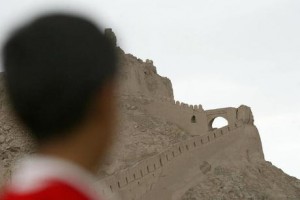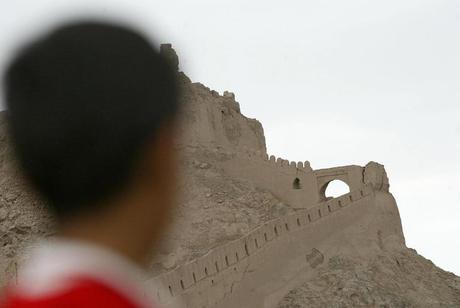 Experts who are painstakingly rebuilding the Bam citadel after an earthquake destroyed it a decade ago say Iran's architectural masterpiece will never return to its past glory but are hopeful they will restore some of it.
Experts who are painstakingly rebuilding the Bam citadel after an earthquake destroyed it a decade ago say Iran's architectural masterpiece will never return to its past glory but are hopeful they will restore some of it.A thousand kilometers (600 miles) southeast of Tehran, the pre-Islamic desert citadel was the largest adobe monument in the world made of non-baked clay bricks.
But it was reduced to rubble on December 26, 2003, when it was hit by a major quake that killed 26,000-32,000 people, according to various estimates.
"Bam will never be rebuilt exactly the way it was," said Afshin Ebrahimi, the manager of the reconstruction project.
The citadel can be traced back to the sixth century BC but reached its apogee from the seventh to 11th centuries as it sat on the crossroads of the Silk Road and other trade routes.
A decade after the quake, only part of the massive site has been rebuilt, while wooden scaffoldings are propped up against most of it and gaping holes can be seen along the outer walls.
"We are not aiming at rebuilding the citadel as it was before the quake. We can never do that," Ebrahimi, who is carrying out the work for Iran's culture and heritage authorities, told Agence France Presse.
"The quake, like the local architecture, is part of our history," he said, adding that certain parts of the citadel would be rebuilt while others would merely be stabilized, to reflect the past disaster.
Two rows of arches located a hundred meters (yards) from the entrance give visitors a glimpse inside the work being done. On one side they can see the original architecture and on the other the renovation.
More than 100 people work on the site each day, alongside 20 Iranian experts and others who have come to lend a hand from France, Germany, Italy and Japan.
Japan contributed $500,000 (365,000 euros) through UNESCO, and provided equipment to clear the rubble and carry out restoration work.
"We are the best equipped team in the world," said Ebrahimi.
Dreams of a return of tourists
The Japanese experts are working on a 3D map of the site, while their French and Italian counterparts are focusing on making mud and cement bricks designed to endure future quakes.
"The work will never end," said Ebrahimi.
"We are trying to preserve the sites but, if it rains on an adobe wall, we must rebuild it all over again."
He says the reconstruction drive has had a positive impact on residents of the modern city of Bam, which lies at the foot of the citadel.
Survivors who lost family members in the quake are still haunted by memories of the tragedy, Ebrahimi said.
"To see the citadel being reborn has a soothing effect. This is a very special project, it is very emotional. It is not just a renovation workshop," he added.
Ebrahimi hopes that restoring the citadel will bolster tourism arrivals in Bam, which is also home to some 150 lesser-known archeological sites.
Bam Governor Hossein Zainol Salehi expressed satisfaction with the pace of the work, saying reconstruction must be done in a "prudent and appropriate" fashion.
The United Nations Educational, Scientific and Cultural Organisation said there had been improvements in the site's management and conservation, and removed Bam from UNESCO's list of "World Heritage in Danger."
"This is a great honor for Bam," said the governor, because "it shows that the right steps have been taken to rebuild the citadel."
Akbar Panjalizadeh agrees, and has rebuilt his tourist hostel and created more room to be ready for the return of holidaymakers.
Panjalizadeh says he dreams of seeing 10 or even 15 tour buses parked outside the citadel. But for the time being he gets only 10 clients a week, half the number who came a decade ago.
By Nahar Net
The Iran Project is not responsible for the content of quoted articles.











